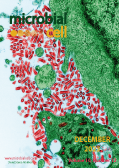Current Issue:
Table of contents
Volume 10, Issue 12, pp. 261 - 295, December 2023
Cover: Colorized transmission electron micrograph of Rabies virus (red), which has heavily infected hamster kidney cells (green) cultured in the lab. Image by the National Institute of Allergy and Infectious Diseases (NIAID), USA, captured and color-enhanced at the NIAID Integrated Research Facility in Fort Detrick, Maryland, USA; image modified by MIC. The cover is published under the Creative Commons Attribution (CC BY) license.
Enlarge issue cover
Extracellular DNA secreted in yeast cultures is metabolism-specific and inhibits cell proliferation
Elisabetta de Alteriis, Guido Incerti, Fabrizio Cartenì, Maria Luisa Chiusano, Chiara Colantuono, Emanuela Palomba, Pasquale Termolino, Francesco Monticolo, Alfonso Esposito, Giuliano Bonanomi, Rosanna Capparelli, Marco Iannaccone, Alessandro Foscari, Carmine Landi, Palma Parascandola, Massimo Sanchez, Valentina Tirelli, Bruna de Falco, Virginia Lanzotti and Stefano Mazzoleni
Research Articles |
page 277-295 | 10.15698/mic2023.12.810 | Full text | PDF |
Abstract
Extracellular DNA (exDNA) can be actively released by living cells and different putative functions have been attributed to it. Further, homologous exDNA has been reported to exert species-specific inhibitory effects on several organisms. Here, we demonstrate by different experimental evidence, including 1H-NMR metabolomic fingerprint, that the growth rate decline in Saccharomyces cerevisiae fed-batch cultures is determined by the accumulation of exDNA in the medium. Sequencing of such secreted exDNA represents a portion of the entire genome, showing a great similarity with extrachromosomal circular DNA (eccDNA) already reported inside yeast cells. The recovered DNA molecules were mostly single strands and specifically associated to the yeast metabolism displayed during cell growth. Flow cytometric analysis showed that the observed growth inhibition by exDNA corresponded to an arrest in the S phase of the cell cycle. These unprecedented findings open a new scenario on the functional role of exDNA produced by living cells.
The Hrk1 kinase is a determinant of acetic acid tolerance in yeast by modulating H+ and K+ homeostasis
Miguel Antunes, Deepika Kale, Hana Sychrová and Isabel Sá-Correia
Research Articles |
page 261-276 | 10.15698/mic2023.12.809 | Full text | PDF |
Abstract
Acetic acid-induced stress is a common challenge in natural environments and industrial bioprocesses, significantly affecting the growth and metabolic performance of Saccharomyces cerevisiae. The adaptive response and tolerance to this stress involves the activation of a complex network of molecular pathways. This study aims to delve deeper into these mechanisms in S. cerevisiae, particularly focusing on the role of the Hrk1 kinase. Hrk1 is a key determinant of acetic acid tolerance, belonging to the NPR/Hal family, whose members are implicated in the modulation of the activity of plasma membrane transporters that orchestrate nutrient uptake and ion homeostasis. The influence of Hrk1 on S. cerevisiae adaptation to acetic acid-induced stress was explored by employing a physiological approach based on previous phosphoproteomics analyses. The results from this study reflect the multifunctional roles of Hrk1 in maintaining proton and potassium homeostasis during different phases of acetic acid-stressed cultivation. Hrk1 is shown to play a role in the activation of plasma membrane H+-ATPase, maintaining pH homeostasis, and in the modulation of plasma membrane potential under acetic acid stressed cultivation. Potassium (K+) supplementation of the growth medium, particularly when provided at limiting concentrations, led to a notable improvement in acetic acid stress tolerance of the hrk1∆ strain. Moreover, abrogation of this kinase expression is shown to confer a physiological advantage to growth under K+ limitation also in the absence of acetic acid stress. The involvement of the alkali metal cation/H+ exchanger Nha1, another proposed molecular target of Hrk1, in improving yeast growth under K+ limitation or acetic acid stress, is proposed.










